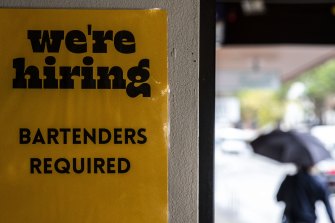
Don’t be fooled: Good economic stories often sound like bad news
My grandma had a favourite saying which she cross-stitched into a sign which hung on the wall of her bathroom. I have a replica copy which hangs above my kettle in my kitchen.
It reads: “I can complain because rose bushes have thorns, or rejoice because thorn bushes have roses.” It’s a good daily reminder that, sometimes, perspective is everything.
The jobless queue is now under half a million people for the first time since before the GFC.Credit:Jessica Hromas
Take this rosy picture. Last month, there was an increase in the total number of Aussies employed of 88,400, slightly exceeding the seating capacity of the entire Sydney Olympic stadium. The majority of the increase was for full-time positions.
Some people joined the ranks of the employed from the sidelines, having been previously not looking for or available for work. But a higher number found employment as blessed relief from being on the unemployment queue, which shrank by 54,000 people. The national jobless queue is now under half a million people for the first time since before the global financial crisis.
As a proportion of the total labour force, the number of Australians who are currently looking for, available for, but unable to find work now stands at 3.5 per cent – the lowest since August 1974.
Even more astonishingly, there is now almost one job vacancy being advertised for every unemployed person (480,000 vacancies to 494,000 unemployed). Of course, matching people to the right jobs is a complex thing. But still, that’s a vacancy to jobless ratio of almost 1:1, down from a pre-pandemic norm of 1:3 pre-pandemic (i.e. three unemployed people for every job vacancy).
Given the centrality of having a job to a person’s financial wellbeing, dignity and overall life satisfaction, I dare you to find an economic rose bush that would smell as sweet.
And yet, news of this astonishing development was almost universally met – by the media, politicians and lobby groups alike – with muted caution.
Why? Well, partly, I suspect because it’s far too soon for a newly elected federal government to claim much credit for this historic achievement.
But largely, it’s because every armchair economist can see that a sizzling hot jobs market and economy means borrowers will likely be hit with higher interest costs sooner than anticipated.
I’ve always found this focus on the plight of mortgage holders somewhat perplexing, given the proportions at play. Only roughly one third of Aussie households have a mortgage, the rest being fairly evenly split between those who rent and those who own their homes outright. These latter groups will probably actually benefit from higher interest rates payable on savings.
I can only surmise that guessing the direction of future Reserve Bank moves makes for great sport for finance journalists, not to mention that most editors skew towards owning properties in inner urban areas with rather sizeable mortgages.
And you can always rely on business lobby groups to spot a thorn.
While cautiously welcoming the news, business groups hit the megaphones warning of a “labour shortage crisis”. But where employers see the thorn of labour shortages, workers might take heart that when they go for a job, there’s less competition.
Friends, you might even get a pay rise soon.
Of course, then we can panic about pay rises, too, fretting about a 1970s-style “wage-price spiral”. Last time I checked, union membership is still about a third what it was back then.
Let’s momentarily forget, also, that history shows it’s quite a reasonable thing for workers to receive “real” pay rises over time, which compensate them not only for inflation but also productivity gains.
But wait, we forgot the big one: to panic about falling home prices! It’s true, higher interest rates will take some of the heat out of property values.
On most forecasts, home values are set to hand back most – mind you not all – the supersized gains seen during the pandemic when ultra-low rates drove a borrowing and property buying binge.
Of course, whether you think falling values represent a thorn or a rose depends very much on whether you own the kitchen in which you’ve hung your inspirational morning quote, or are renting it and aspire to own a different kitchen one day (one in which you could hang your sign with a hammer and nail).
Perspective, you see.
Stepping back, it’s not hard to see why past policymakers decided to outsource the important task of setting interest rates to an independent central bank.
Economic policymaking inevitably involves trade-offs – there are both winners and losers from most decisions.
Keeping interest rates too low for too long, would not only lead to the formation of risky bubbles in asset prices like property and shares, but would also mean an economy running too hot and generating too much price pressure. And why is inflation a bad thing? Because it erodes the real value of incomes and savings. Those dollars you’re working so hard to earn – or have already earnt – will suddenly buy you less. That’s not good for anyone.
On balance, history shows we are better off when policymakers do attempt to level off the more extreme swings of the business cycle, including both too hot inflation or too high unemployment.
Sure it’s possible policymakers could take things too far this year and lift interest rates too fast, sucking too much demand out of the economy, in turn slowing demand for labour and leading to higher joblessness again.
Some of the biggest losers could be recent first home buyers who, at the encouragement of governments, took out large mortgages during the pandemic property boom. If you want to worry about someone, worry about them.
For these households, the best protection they can hope for is a healthy jobs market to ensure, in the event of an unexpected job loss, they can find another job.
For most borrowers, however, higher rates will simply mean a bit less eating out, fewer holidays or a lower savings rate, while they continue to work in jobs they can easily find alternatives to, if needed.
Don’t forget to stop and smell the roses.
The Morning Edition newsletter is our guide to the day’s most important and interesting stories, analysis and insights. Sign up here.
Most Viewed in Business
From our partners
Source: Read Full Article


